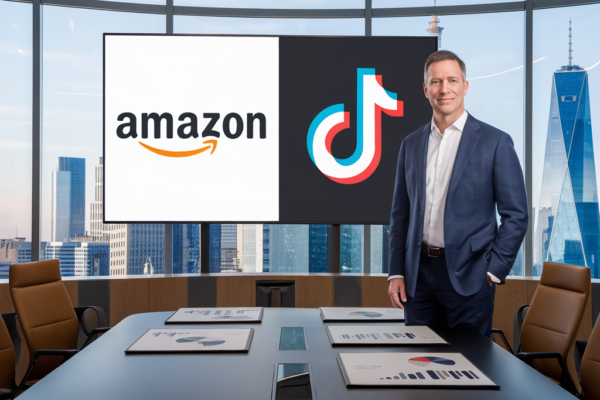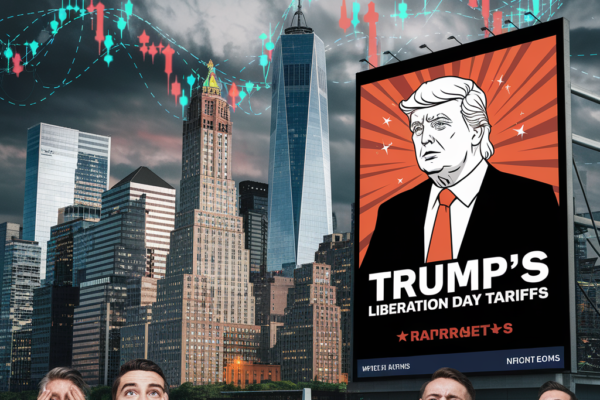In a dramatic twist reflecting the intersection of high fashion and geopolitics, Prada Group has renegotiated its Versace acquisition price downward by $200 million following President Trump’s sweeping tariff announcements. The revised $1.4 billion deal, now hanging in delicate balance, exposes how global trade wars are reshaping luxury sector consolidation. This development comes as financial markets reel from the largest single-day drop since 2020, with the S&P 500 losing 10% value over two days and European luxury stocks plunging 6.97% weekly[1][2][5].
The Tariff Catalyst Reshaping Luxury M&A
Trump’s Protectionist Gamble
President Trump’s April 2025 “Liberation Day” tariffs imposed 25% levies on all automotive imports and 34% reciprocal tariffs on Chinese goods, triggering immediate market chaos[2][5]. The measures caused Capri Holdings’ market value to plummet 23.6% to $14.99, while Prada Group shares fell 4.6% to HK$51.50[3]. This financial volatility forced both parties back to the negotiating table, with Prada leveraging market conditions to secure improved terms[6].
Structural Impacts on Deal Architecture
The tariffs fundamentally altered the acquisition’s risk profile. Versace’s U.S.-based parent Capri Holdings faced dual pressures – a 15% sales decline in Q3 2025 and new import costs on European-manufactured luxury goods[7][3]. Prada’s revised €1 billion ($1.1 billion) offer reflects both companies’ reassessed growth projections under the tariff regime, particularly for Versace’s crucial Asian markets now facing Chinese retaliatory measures[2][6].
Strategic Calculus Behind the Renegotiation
Prada’s Expansion Imperative
Despite 2024’s stellar performance – 25% net profit growth to €839 million – Prada faces intensifying pressure to scale against LVMH’s €86 billion and Kering’s €20 billion revenue bases[7]. The Versace acquisition would immediately boost Prada Group’s turnover past €6 billion, creating Italy’s first homegrown luxury conglomerate capable of challenging French dominance[7][4].
Versace’s Brand Rehabilitation
Once the crown jewel of Italian fashion, Versace has struggled under Capri’s ownership with Q3 2025 sales collapsing to $193 million[7]. Industry analysts suggest Prada intends to restore Versace’s “luxury DNA” by reducing over-commercialization, leveraging Miuccia Prada’s minimalist aesthetic to balance Donatella Versace’s maximalist legacy[7][3]. The appointment of former Miu Miu design director Dario Vitale as Versace’s new creative lead signals this strategic shift[3][6].
Market Fallout and Sector Implications
Luxury Sector Contagion
The tariffs have exposed fault lines across luxury markets. LVMH shares fell 8.2% post-announcement, while Kering dropped 11.7% – contrasted with Prada’s relative resilience at 4.6% decline[3][7]. This divergence highlights Prada’s stronger Asian positioning, where 2024 sales grew 18% compared to LVMH’s 2% China contraction[7].
Ancillary Industry Impacts
Beyond fashion, Trump’s measures have forced 900 layoffs at Stellantis plants and halted production at Mexican auto factories[5]. The broader economic shockwaves – $3.1 trillion in global market losses over two days – create a perilous environment for large-scale M&A[5][8].
Deal Mechanics and Financing Challenges
Revised Transaction Structure
The renegotiated terms include extended payment timelines and earn-out clauses tied to post-tariff sales performance[6]. Prada has reportedly secured favorable financing through Intesa Sanpaolo, leveraging its Hong Kong listing to access Asian capital markets less affected by U.S. trade policies[3][7].
Antitrust Considerations
Despite reduced scrutiny compared to Capri’s blocked Tapestry merger, regulators remain focused on combined market share in leather goods (Prada 8%, Versace 3%) and haute couture[3][6]. The European Commission has initiated preliminary reviews citing potential impacts on Italian SME suppliers[6].
Historical Parallels and Future Scenarios
Precedent Transactions
The deal echoes LVMH’s 2017 Dior acquisition during EU-China trade tensions, which succeeded through similar price renegotiations[4]. However, Kering’s failed 2023 attempt to acquire Valentino during Fed rate hikes serves as cautionary tale[7].
Contingency Planning
Sources indicate Prada has developed three scenario models: 1) Full acquisition under current terms (60% probability), 2) Joint venture structure (30%), and 3) Abandonment with €150 million breakup fee[6][8]. The Versace family’s final approval remains the critical unresolved factor[1][6].
Conclusion: A Bellwether for Globalized Luxury
As Prada and Capri approach Thursday’s putative signing deadline, the deal has become a litmus test for cross-border M&A in the tariff era. Success could inspire similar European consolidations, while failure might accelerate luxury sector retreat into regional silos. With China imposing 34% retaliatory tariffs and the Eurozone considering defensive measures, the Versace acquisition’s fate will reverberate far beyond Milan’s fashion houses[2][5][6].
Sources
https://www.investing.com/news/stock-market-news/capri-stock-rises-following-wsj-report-on-versace-sale-talks-93CH-3977284, https://biztoc.com, https://www.nssmag.com/en/fashion/40638/prada-acquisition-versace-jimmy-choo-2025, https://www.investopedia.com/capri-stock-soars-on-report-prada-moving-closer-to-buying-versace-11689473, https://upstract.com, https://www.globalbankingandfinance.com/VERSACE-M-A-PRADA-3239c010-3558-4fa0-9b7a-883f609ce04f, https://www.nbcrightnow.com/national/prada-shines-despite-luxury-crisis-versace-rumours-swirl/article_5cb3263f-7687-5109-9916-e028c34e32a7.html, https://www.tipranks.com/news/the-fly/prada-tentative-deal-to-acquire-versace-from-capri-at-risk-wsj-reports





